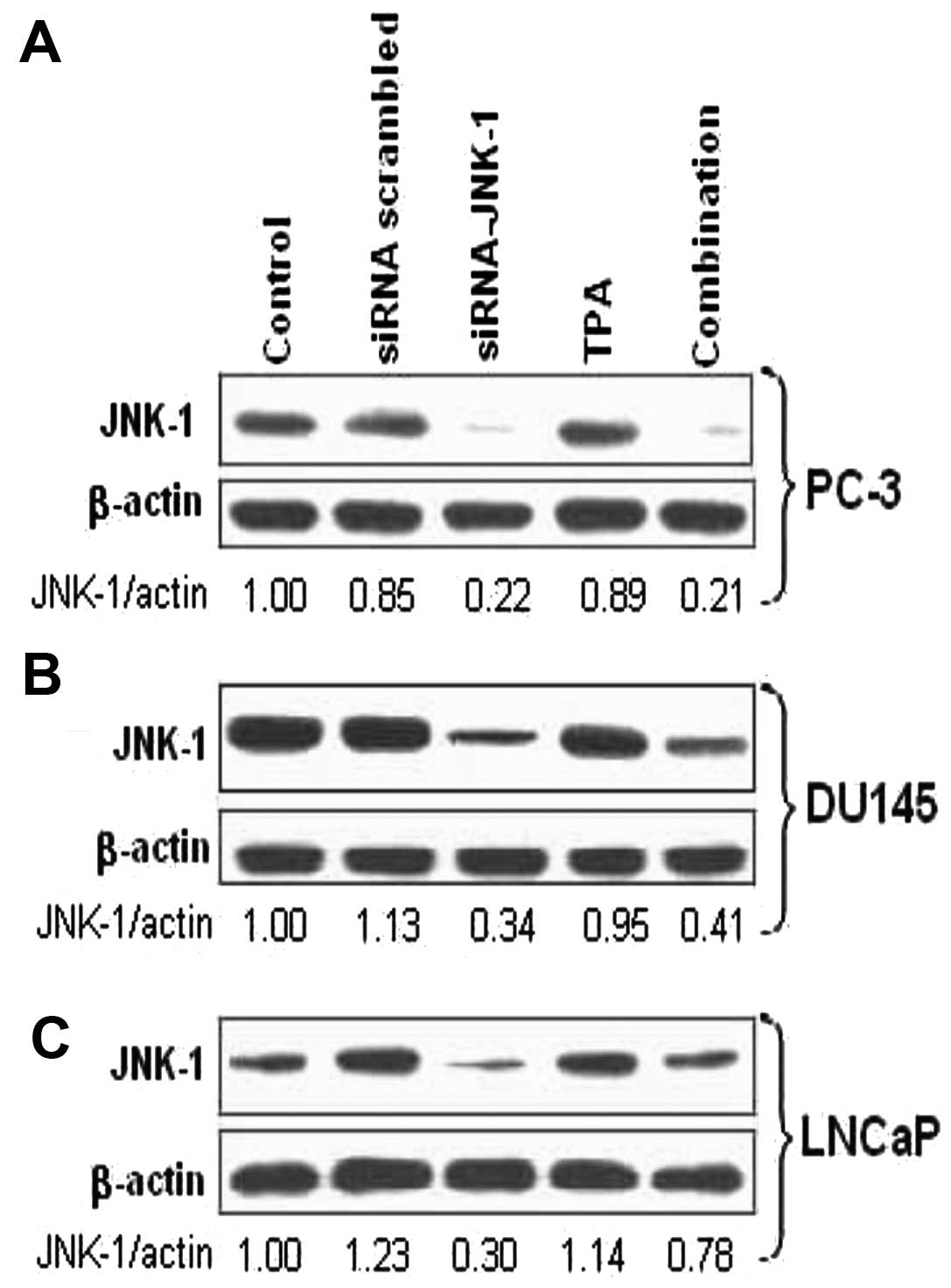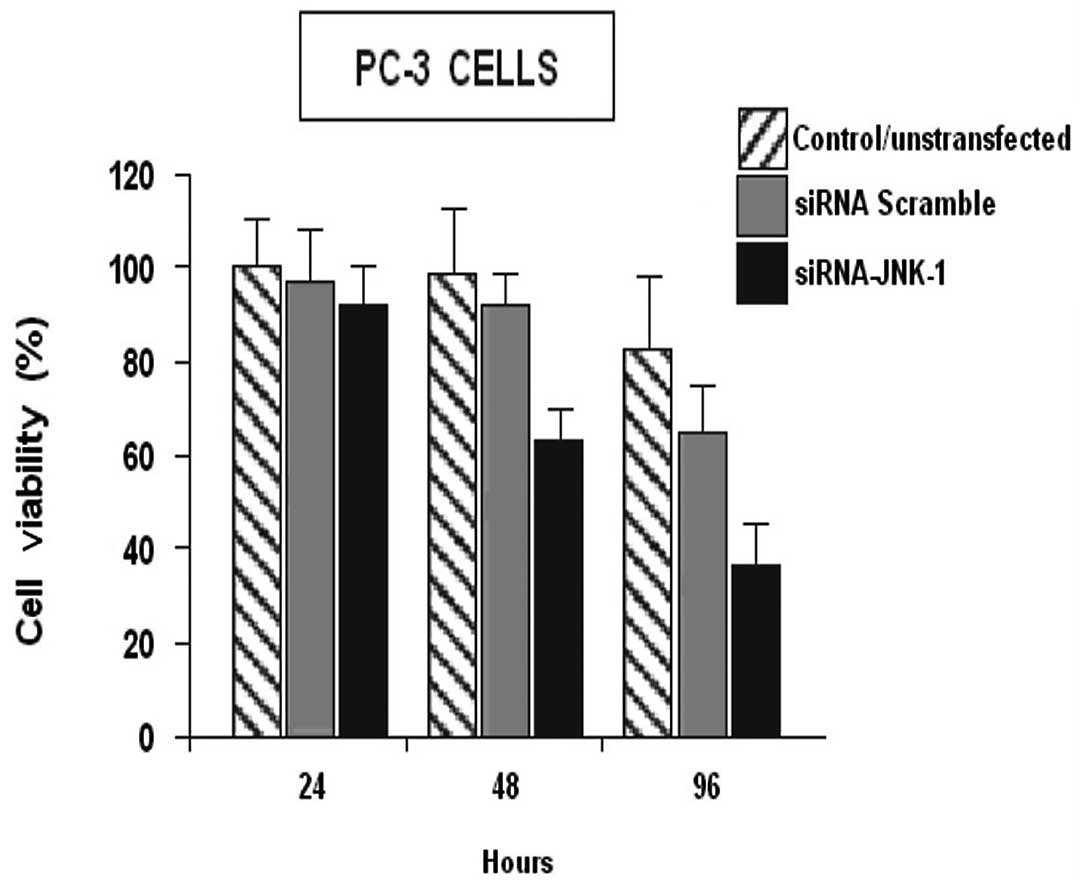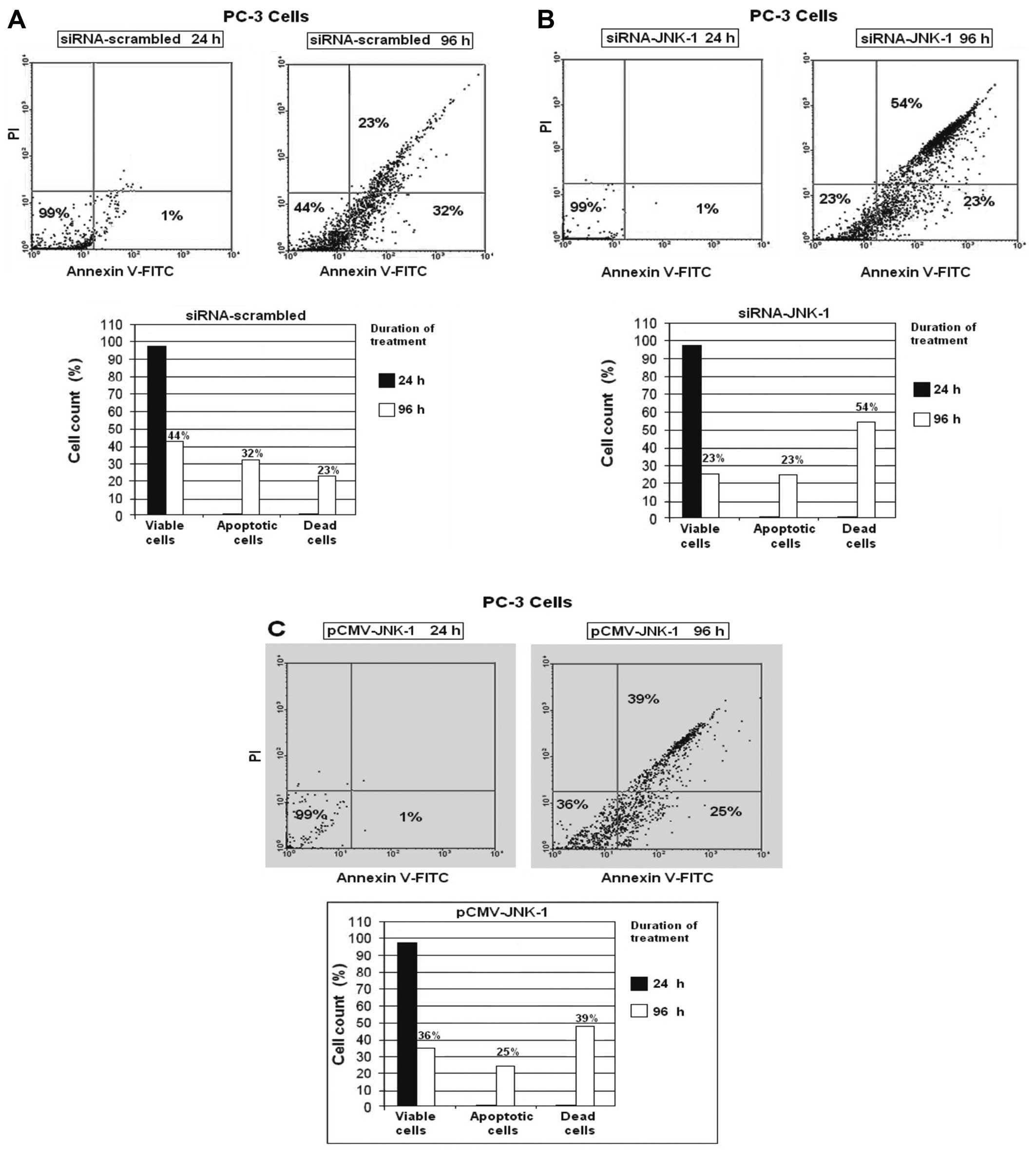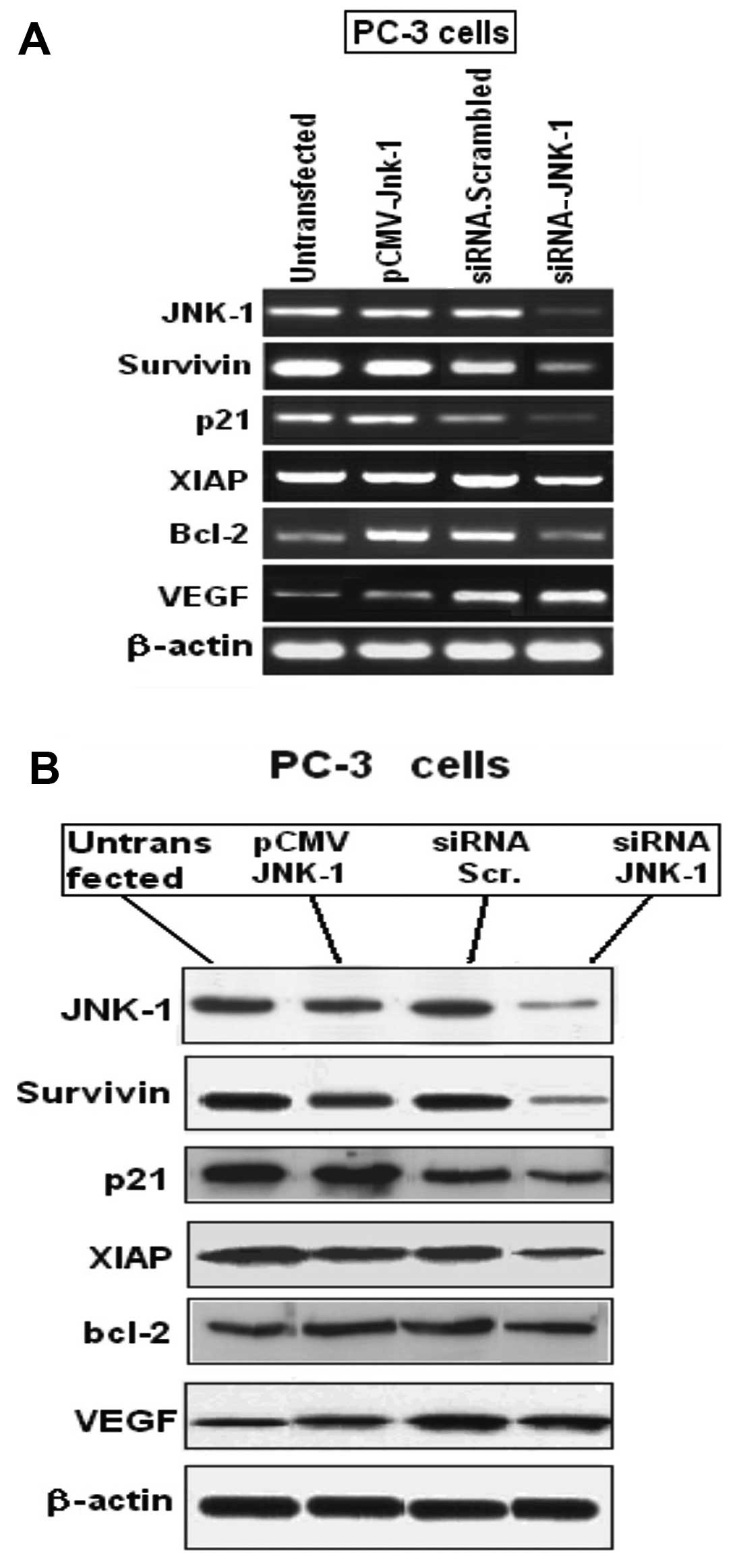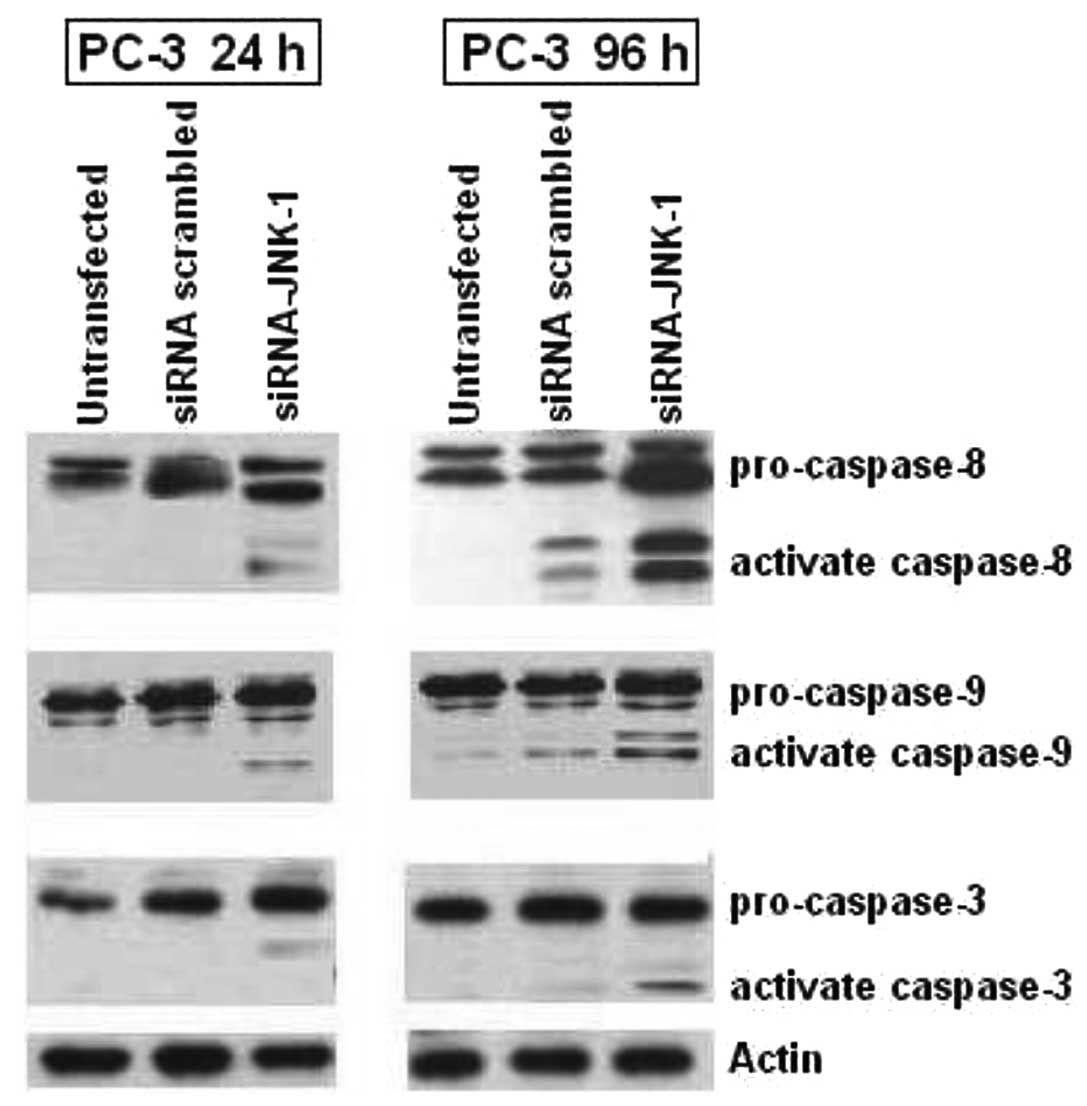Inhibition of JNK-1 by small interfering RNA induces apoptotic signaling in PC-3 prostate cancer cells
- Authors:
- Published online on: July 5, 2012 https://doi.org/10.3892/ijmm.2012.1055
- Pages: 923-930
Abstract
Introduction
Prostate cancer (PC) is the most frequently diagnosed cancer and the second-leading cause of cancer-related deaths in men worldwide (1,2). The general prognosis for diagnosed PC remains inadequate and advanced PC is difficult to treat successfully (3,4). Therefore, a better understanding of the nature and underlying causes of PC will lead to improved treatment.
c-Jun-NH2-terminal kinases (JNKs), is believed to participate in most aspects of cellular function, including replication, growth, metabolism, differentiation, and apoptosis (5–7). JNKs, belonging to the group of stress-activated protein kinases (SAPKs), are encoded by three genes, namely JNK-1 and JNK-2 that are ubiquitously expressed, and JNK-3, whose expression is restricted to the brain, heart and testis (7–9). The role of JNKs in apoptosis is unclear because these proteins have been assigned both pro- and anti-apoptotic properties. JNK becomes activated through phosphorylation and some tumour cell lines contain constitutively active JNK (10–12). Anti-sense JNK oligonucleotides have been reported to inhibit the growth of such tumor cells and induce apoptosis (13,14). In contrast, activated JNK is required for UV-induced apoptosis and is suggested to be essential for cytochrome c release from mitochondria in mouse fibroblasts (15). The role of JNKs in several cancers has been extensively examined in many studies over the past decade (16). Reducing JNK levels by genetic means in established breast cancer cell lines will lead to a better understanding of its role in maintaining the malignant phenotype (12). PC progression is accelerated by reducing the level of apoptosis in cancerous cells, suggesting that defects in apoptosis may participate in prostate carcinogenesis. JNK-1 is a member of a highly conserved mitogen-activated protein kinase superfamily (MAP kinases) which also includes p38, and ERK. JNK phosphorylates and augments the transactivating activity of many transcription factors, which control the expression of various genes. Previous studies in our laboratory and in others laboratories have shown that JNK-1 is involved in and required for apoptosis signaling induced by various agents (7,17). We have shown that JNK activity is required for breast cells to grow and surve (12). However, the molecular mechanism by which JNK is involved in apoptosis in PC and the mechanism by which JNK is regulated during apoptosis have not been fully characterized.
To the best of our knowledge, programmed cell death, or apoptosis, is a way for the organism to tightly control the cell number and tissue size, and to prevent cancer from developing. Apoptosis, is a regulated, complex process through which normal cells in the body die after a specified life span. Cells that are defective, damaged or redundant are eliminated. Multicellular organisms use apoptosis, to eliminate abnormal or unwanted cells (18,19). All cancer cells, as a result of accumulated mutations fail to execute apoptosis, allowing them to live indefinitely and grow uncontrollably. Breakdown of the cellular apoptosis regulatory machinery is a hallmark of cancer. Although the normal apoptotic pathways are defective, many cancer cells are resistant or develop resistance to these agents. Several families of proteins that can block apoptosis in normal cells have been studied in cancer cells (20). These include the Bcl-2 family of proteins, p53 tumor suppressor protein and the inhibitors of apoptosis proteins (IAPs) (20,21). IAP are a family of functionally- and structurally-related proteins, which serve as endogenous inhibitors of programmed cell death (20,21). The human IAP family consists of 8 members, and IAP homologs have been identified in numerous organisms. The first members of the IAPs identified were IAPs, Cp-IAP and Op-IAP, which bind to and inhibit caspases as a mechanism that contributes to its efficient infection and replication cycle in the host. Later, 5 more human IAPs were discovered which included XIAP, c-IAP1, c-IAP2, NAIP and survivin (22,23). XIAP, which binds caspases-9, -3 and -7, inhibiting their activation and prevents apoptosis (21). Also c-IAP1 and c-IAP2 have been shown to bind caspases, although how the IAPs inhibit apoptosis mechanistically at the molecular level is not completely understood. In the present study, we used RNA interference to eliminate JNK-1 expression in PC-3 cells and studied which apoptotic proteins are involved or affected after knockdown of JNK-1. We showed by western blotting, Annexin V, and cell viability that the siRNA complementary to JNK-1 mRNA was able to inhibit the expression of their respective target, promoting apoptosis and cell death. In addition, protein expression of Bcl-2, XIAP and survivin were affected after blocking of JNK-1 protein expression by siRNA-JNK-1 treatment. Our results suggest that siRNA against JNK-1 induced-cell death occurs via the activation of caspases. Interference RNA-specific depletion of JNK-1 in PC-3 cells greatly reduced JNK-1 activity induced by TPA and completely blocked both cell growth and cell survival, suggesting that inhibition of JNK-1 represents a necessary and early step for the induction of apoptosis in the prostate carcinoma cell line PC-3.
Materials and methods
Cell lines and culture
The human prostate carcinoma cell line PC-3 was a gift from Dr Dan Mercola (The Sidney Kimmel Cancer Center, La Jolla, CA, USA). The cells were cultured in RPMI-1640 medium supplemented with 100 ml/l fetal bovine serum (FBS), 8x105 U/l penicillin and 0.1 g/l streptomycin in a humidified incubator containing 50 ml/l CO2 at 37°C (14,15). The antibodies used for western blotting included those against protein kinase JNK-1, survivin, XIAP, Bcl-2, p21 and VEGF (Santa Cruz Biotechnology, Inc., Santa Cruz, CA, USA), against caspases-3, -8, -9, cytochrome c, β-actin (Sigma, St. Louis, MO, USA), and cytochrome oxidase subunit IV (Cox IV; Invitrogen, Carlsbad, CA, USA). Western blotting was performed as previously described (23–26).
siRNA preparation and transfection of small interfering RNA
Human PC-3 cells were seeded one day prior to transfection at 30x103 cells/cm2. The cells were transfected with 1 μg (12-well plate) of JNK-1, sense (5′-AAGCCCAGTAATATAGTA GTA-3′), antisense (5′-ACGTGACACGTTCGGAGAATT-3′) together with 6 μl RNAiFect Transfection Reagent according to the manufacturer’s instructions (Qiagen, Germantown, MD, USA). Optimal transfection conditions were determined by transfection with Alexa Fluor 555 labeled non-silencing siRNA, consisting of a scrambled sequence with no homology to mammalian genes and (sense, 5′-AATTCTCCGAACGT GTCACGT-3′ and antisense, 5′-ACGTGACACGTTCGGAG AATT-3′). The cells were incubated at standard culture conditions (37°C, 5% CO2) and after 8 h, the siRNA transfection medium was replaced with a fresh medium. A significant decrease in protein level was observed 48 h following siRNA addition. Silencing of JNK by siRNA was confirmed by western blot analysis. All siRNA and reagent used were obtained from Qiagen.
Western blot analysis
PC-3 carcinoma cells (5x105) were seeded onto 6-well plates. Forty-eight hours after transfection, cells were collected and washed twice by cold PBS, and each well was treated with 50 ml lysis buffer (2 mmol/l Tris-HCl, pH 7.4, 50 mmol/l NaCl, 25 mmol/l EDTA, 50 mmol/l NaF, 1.5 mmol/l Na3VO4, 1% Triton X-100, 0.1% SDS, supplemented with protease inhibitors 1 mmol/l phenylmethylsulfonylfluoride, 10 mg/l pepstatin, 10 mg/l aprotinin and 5 mg/l leupeptin) (Sigma). Protein concentrations were determined using the Bradford protein assay. Equal amounts of protein (50 μg) were separated on a 15% SDS polyacrylamide gel and transferred to a nitrocellulose membrane (Hybond C; Amersham Pharmacia Biotech, Freiburg, Germany). Membranes were blocked in 5% non-fat dry milk in TBS for 1 h at room temperature and probed with rabbit anti-JNK-1 (sc-1648) antibody dilution, 1:500 (Santa Cruz Biotechnology, Inc.) overnight at 4°C. After washing 3 times with TBS containing 0.1% Tween-20, membranes were incubated with anti-rabbit IgG-horseradish-peroxidase (1:5,000; Santa Cruz Biotechnology, Inc.), and developed by luminal mediated chemiluminescence (Appylgen Technologies, Inc., China). To confirm equal protein loading, membranes were re-proped with a 1:1,000 dilution of an anti-actin antibody (Santa Cruz Biotechnology, Inc.). Densitometric analyses were performed using the Scion Image software (12).
Measurement of caspase activity
Cells were washed with ice-cold PBS and lysed with 100 μl of lysis buffer [50 mM Tris-HCl (pH 7.5), 150 mM NaCl, 1 mM EGTA, 1 mM NaF, 1% Nonidet P-40, 1 mM PMSF, protease inhibitor cocktail] for 30 min at 4°C. Protein extracts were collected after centrifugation at 14,000 rpm for 10 min. Protein concentration was determined using the Bio-Rad protein assay kit (Bio-Rad, USA). Equal amounts (50 μg) of protein extracts were mixed with an assay buffer [20 mM HEPES (pH 7.4), 100 mM NaCl, 0.1% CHAPS, 10 mM DTT, 1 mM EDTA, 10% sucrose], added to 96-well microtiter plates, and incubated with 100 μM of fluorogenic substrates, specific for caspase-3 (Ac-DEVDAMC), Ac-IETD-AMC, (caspase-8) and Ac-LEHD-AMC (caspase-9) for 1 h at 37°C. Free aminomethylcoumarin (AMC) resulting from cleavage of the aspartate-AMC bond by caspase was measured at an excitation wavelength of 380 nm and an emission wavelength of 460 nm using a spectrofluorometer (Geminin E; Molecular Devices, USA) (27).
Measurement of DNA fragmentation
The degree of DNA fragmentation was determined using a Cell Death ELISA kit (Roche Diagnostics, Indianapolis, IN, USA). PC-3 cells (50,000) were treated with apoptotic compounds for the indicated periods of time. Cells were harvested by centrifugation and lysed in 0.5 ml of the lysis buffer provided with the kit. Two microliters of the extract was used for the ELISA, which was performed as instructed by the manufacturer. The OD at 405 nm was measured and the fold induction of apoptosis was calculated using untreated cells as a control.
Reverse transcription polymerase chain reaction
PC-3 cells (5x105) were seeded onto 6-well plates and treated with scrambled siRNA or siRNA-JNK-1. Total-RNA was extracted 48 h after transfection using TRIzol reagent. Reverse transcription was performed using a one step RT-PCR kit. All assays were performed in triplicate and results were plotted as average ± SD. The primers were: JNK-1, forward, CGTCTGGTGGAAGGA GAGAG and reverse, TAATAACGGGGGTGGAGGAT; survivin, forward, GCCATGAATTCATGGGTGCCCCGACG TGACGTTGC and reverse, AGCTCTCTAGAGAGGCCTC AATCCATGGCA; p21/WAF-1, forward, ATGAAATTCACCC CCTTTCC and reverse, CCCTAGGCTGTGCTCACTTC; XIAP, forward, GCACGAGCAGGGTTTCTTTATACTGGTG and reverse, CTTCTTCACAATACATGGCAGGGTTCCTC; Bcl-2, forward, ACTTGTGGCCCAGATAGGCACCCAG and reverse, CGACTTCGCCGAGATGTCCAGCCAG; and VEGF, forward, GGCAGAAGGAGGAGGGACAGAATC and reverse, CATTTACACGTCTGCGGATCTTGT. The primers of human β-actin were forward, 5′-TCACCAACTGGGACGACAT-3′ and reverse primer, 5′-GAAGTCCAGGGCGACGTAG-3′. Thermal cycle conditions were as follows: 42°C for 30 min, 94°C for 2 min, followed by 28 cycles of 94°C for 15 sec, 55°C for 30 sec, 72°C for 1 min, with a final extension at 72°C for 10 min. RT-PCR products were visualized by ethidium bromide-stained agarose gels and the images were scanned using UV light.
Cell viability was determined using the 3-(4–5 dimethylthiozol-2-yl) 2–5 diphenyl-tetrazolium bromide (MTT) assay
PC-3 cells (2x104 cells/well) were incubated in a 96-well plate containing 200 μl of medium. The cells were divided into three groups: i) untransfected group; ii) scrambled siRNA group; and iii) siRNA-JNK-1 group. Transfection of siRNAs was conducted the following day as described previously. The rate of cellular proliferation was measured for 24, 48 and 96 h. At the end of each time point, 20 μl of 5 mg/ml MTT (Sigma) was added to each well. Four hours later, 200 μl of DMSO was added to the MTT-treated wells and the absorption at 492 nm was determined with a spectrometer. Each experimental condition was carried out in triplicate (28).
Flow cytometry for cell apoptosis detection
PC-3 cells were plated in 6-well plates and were divided into three groups: i) the scrambled siRNA group; ii) the siRNA-JNK-1 group; and iii) the pCMV-JNK-1 group. Transfection of siRNAs was performed the following day as described previously. The siRNA transfection treatment remained the same. After 24 and 96 h, cells were collected and washed twice with pre-chilled PBS. The cell concentration was adjusted to 5x105–5x106 cells/well with 100 μl of pre-chilled binding buffer. Five microliters of Annexin V-FITC and 5 μl of propidium iodide (PI) were added to each sample and incubated for 10 min in the dark on ice. Pre-chilled binding buffer (400 μl) was added at the end. The cell apoptosis was determined by flow cytometry. Apoptosis of each group was assayed three times (29).
Results
Endogenous JNK-1 expression in various prostate cancer cells transfected with siRNA-JNK-1 or a scrambled siRNA, or the combination of siRNA-JNK-1 and TPA
Treatment of prostate carcinoma cells with siRNA-against JNK-1 but not with a scrambled siRNA, led to markedly decreased JNK-1 protein level in PC-3, DU145 and LNCaP cells (Fig. 1). Treatment of cells with TPA further increased the expression of JNK-1 which was decreased when cultured in combination with siRNA-JNK-1. The endogenous JNK-1 protein expression was detectable by western blot analysis in all the prostate carcinoma cell lines treated (Fig. 1).
siRNA-JNK-1 inhibited cell viability in the prostate PC-3 cell line
Decreased JNK-1 activity is associated with arrested cell growth. Therefore, we examined whether the siRNA-JNK-1, would affect cell viability in the PC-3 cell lines. PC-3 cells were transfected with scrambled siRNA or with siRNA-JNK-1 as previously, and the amount of viable cells was determined by the MTT assay for 24, 48 and 96 h (Fig. 2).
The ability of surviving cells to mitotically expand into colonies forming a viable cell mass may be assessed by the ability of the cell mass to reduce tetrazolium dyes. Viability was assessed for 24, 48 and 96 h respectively, following siRNA-JNK-1 treatment (Fig. 2). At 24 h after treatment, the survival of PC-3 cells was 91%. At 48 h after treatment the survival of PC-3 cells was 66.3%. At 96 h of treatment the survival of PC-3 cells was 40.7%. siRNA-JNK-1 significantly decreased the percentage of viable PC-3 cells, compared to the control PC-3 cells or with the cell overexpressing JNK-1 (pCMV-JNK-1). These observations suggest, that the continuous expression of JNK-1 is necessary for normal proliferation of PC-3 cells.
Transfection with siRNA against JNK-1, strongly induces apoptosis in PC-3 cells
Detection of apoptosis of PC-3 cells was conducted using flow cytometric analysis. To determine whether the decrease in cell viability caused by the siRNAJNK-1 was due to an increase in apoptosis or a decrease in cell proliferation, we determined the amount of apoptotic cells from the scrambled transfected, control siRNA-transfected and pCMV-JNK-1 transfected cells by Annexin V-FITC and propidium iodide (PI) labeling followed by fluorescence-activated cell sorting. In the flow cytometric analysis, a double labeling technique, using Annexin V-FITC and PI, was utilized. The lower left (LL) quadrant (Annexin V−/PI−) is regarded as the population of live cells; the lower right quadrant (LR) (Annexin V+/PI−) is considered the cell population at early apoptotic stage; the upper right (UR) quadrant (Annexin V+/PI+) represents the cell population at the late apoptotic stage and the upper left (UL) quadrant (Annexin V−/PI+) is considered the necrotic cell population. Flow cytometric data analysis revealed that after 96 h of treatment of PC-3 cells with scrambled siRNA, 44% of cells were in the LL quadrant; 32% of cells were in LR quadrant (early apoptotic stage) and 23% of cells were in UR quadrant (late apoptotic stage/dead cells) (Fig. 3A).
We observed that after 96 h of treatment of PC-3 cells with siRNA-against JNK-1 (siRNA-JNK-1) 23% of PC-3 cells were in the LL quadrant; 23% of cells were in the LR quadrant (early apoptotic stage) and 54% of cells were in the UR quadrant (late apoptotic stage/dead cells) (Fig. 3B). After 96 h of treatment of PC-3 cells with a vector expressing the JNK-1 protein (pCMV-JNK-1), 36% of PC-3 cells were in the LL quadrant; 25% of cells were in the LR quadrant (early apoptotic stage) and 39% of cells were in the UR quadrant (late apoptotic stage/dead cells) (Fig. 3C). No significant percentage of cells was in the UL quadrant.
Inhibition of JNK-1 expression decreases the expression of some key cell cycle regulatory genes
To identify the mechanisms through which JNK-1 depletion may cause cell cycle arrest, apoptosis and cell death, we focused on the function of JNK-1 as a transcription-regulatory protein. We examined whether JNK-1 regulated the expression of key genes coding for proteins involved in cell cycle control at the G0/G1 phase. PC-3 cells were transfected with a pCMV-JNK-1 or scrambled siRNA (control) or siRNA-JNK-1. Relative changes in mRNA levels of a panel of candidate genes including JNK-1, survivin, p21WAF1, XIAP, Bcl-2 and VEGF, were assayed by quantitative real time RT-PCR (Fig. 4A). The mRNA levels of these genes were significantly decreased after siRNA-JNK-1 treatment in assays performed on cDNA samples from 3 independent transfections. Western blot analysis showed that JNK-1, survivin, p21WAF1, XIAP and Bcl-2, protein levels were decreased upon JNK-1 depletion (Fig. 4B).
Of all the JNK-1 target genes analyzed, survivin, p21WAF1, and XIAP had the strongest decrease in expression (Fig. 4). Since the decreased expression of survivin, p21WAF1 and XIAP could be associated with cell cycle arrest in G0/G1, we sought to understand the mechanisms through which JNK-1 may regulate expression of survivin, p21WAF1 and XIAP. Survivin and XIAP belong to a family of proteins that suppress apoptosis by inhibition of caspases in some cancer. Both confer resistance to apoptosis induction by chemotherapeutic agents.
Activation of pro-caspases is accelerated after inhibition of JNK-1 expression by siRNA-JNK-1 in PC-3
Caspases are important mediators of apoptosis. Activation of caspases-8, -9 and -3 by enzymatic cleavages is a hallmark event in caspase-dependent apoptosis. We investigate caspases-8, -9 and -3 activation by western blotting Fig. 5. We determined if the apoptosis induced by decreased activity of JNK-1 by siRNAJNK-1 in PC-3 prostate carcinoma cell line was accompanied by increased activation of caspases (Fig. 5). Consistent with the response to apoptosis and cell death observed in cells treated with siRNA-JNK-1 (Fig. 3B), we observed that blocking of JNK-1 expression induced cleavage of pro-caspase-8, which is an initiator caspase linked to the receptor-mediated apoptotic pathway. This effect was increased in PC-3 cells after 96 h of treatment as compared to the PC-3 transfected with a scrambled siRNA or with untransfected cells, respectively. The proteolytic processing of caspase-9, was significantly induced in PC-3 cells compared to cells treated with scrambled siRNA or untransfected cells. In addition, the cleavage of procaspase-3 was weakly increased by blocking JNK-1 expression in PC-3 cells compared with untransfected or transfected cells. The data suggested involvement of both caspases-9 and -8 pathways in siRNA-JNK-1-induced cell death and that the apoptosis was at least in part due to the decreased expression of JNK-1.
Discussion
It is well known that JNK is activated and contributes to the induction of apoptosis with a variety of extracellular stresses (30), but its impact on prostate cancer cell survival remains controversial (31,32). We have previously shown that phosphatase PP4, acts in synergy with signals induced by cisplatin and EGF, triggering an overexpression of JNK-1. Eventually this would lead to a greater anti-apoptotic response by keeping low the activity of one specific JNK-1 phosphatase and by inducing activation of genes involved in the DNA damage response pathway (23). In this study, we have demonstrated that in PC-3 cells, siRNA-JNK-1 exerted multiple effects on the viability and cell growth and evoked apoptosis via a pathway dependent on caspases. Apoptosis is a carefully regulated process of cell death that occurs as a normal part of development. Inappropriately regulated apoptosis is implicated in disease states, such as Alzheimer’s disease and cancer (33,34). In this regard, it has been shown that the diverse JNK-mediated responses appear to be cell type-specific (35). JNK-1 activity was shown to be critical for apoptosis in several cell types including PC12 cells (15) and U937 cells (36). Accumulating evidence suggests that the MAP kinase family of proteins are critical for the induction of cell death or survival (15,37,38). The kinase JNK-1 is highly expressed in most human cancers, including breast, prostate, gastrointestinal cancer, lymphoma, melanoma, and myeloid leukemia (37–39). Altered expression of JNK-1 or JNK-2 seems to define a common event associated with the pathogenesis of several human cancer types (40,41).
Our results strongly suggest that the siRNAs used were specific for JNK-1 and validates the use of this approach to alter expression of the endogenous protein. Indeed, expression of human JNK-1 in siRNA knockdown PC-3 cells promotes apoptosis, which further suggests the phenotypic changes in these structure is specifically due to the loss of endogenous JNK-1. Previous studies regarding prostate cancer demonstrated that the continued presence of JNK-1/2 was required for cancer development in combination with cisplatin (42,43) and that inactivation of JNK-1/2 resulted in the sustained regression of tumors (43,44). Although some studies previously revealed that the effects of inactivation of JNK-1/2 in some cell lines were modest, other groups using different approaches to reduce the protein level of JNK-1/2 found that a decrease in JNK-1/2 expression could inhibit the growth of several tumor cells, including breast tumor cells (45,46). Our results are consistent with a causal role of JNK-1 in transformation of PC-3 prostate carcinoma. We demonstrated that siRNA against JNK-1 can effectively downregulate JNK-1 overexpression with great specificity. We showed that the siRNA-JNK-1 could successfully induce apoptosis and cell death up to 54% as demonstrated by the Annexin V/PI assay in PC-3 cells treated with siRNA-JNK-1 96 h after transfection (Fig. 3). In addition, blocking of JNK-1 expression causes a decrease in the expression of survivin, p21, XIAP and Bcl-2, all of which are anti-apoptotic proteins, promoting the process of apoptosis (Fig. 4). Several reports have shown that JNK phosphorylates the anti-apoptotic protein Bcl-2 and Bcl-x, although the consequences of this phosphorylation are unclear. It is possible that phosphorylation of these proteins impairs their anti-apoptotic function, contributing to the induction of apoptosis (47). A cell viability assay, showed a strong decrease in cell proliferation after siRNA-JNK-1 treatment. These observations suggest, that the continuous expression of JNK-1 is necessary for normal proliferation of PC-3 cells. Therefore, we determined whether the increased susceptibility of prostate cancer PC-3 cells overexpressing endogenous JNK-1 to siRNA-JNK-1 induced apoptosis was accompanied by the increased activation of caspases (Fig. 5). Blocking of JNK-1 expression by siRNA induced a cleavage of pro-caspase-8, which is an initiator caspase linked to the receptor-mediated apoptotic pathway. The proteolytic processing of caspase-9, which has been linked to the mitochondrial death pathway, was significantly induced in PC-3 cells following treatment with siRNA-JNK-1 compared to control cells. In addition, the cleavage of pro-caspase-3 was very weak in two similar experiments. In fact, caspase-3 activity is thought to be essential for DNA fragmentation. These results indicate that the mitochondrial instability led to apoptosis through the cytochrome c-mediated activation of caspases-9 and -8. These data are consistent with the suggestion that the siRNA against JNK-1 or JNK-2 is capable of inducing DNA fragmentation and apoptosis in PC-3 cells.
In summary, we have shown that siRNA against JNK-1 promoted apoptosis in the human prostate carcinoma PC-3 cell line, and this effect is partly due to the downregulation of Bcl-2, survivin, p21WAF1, and XIAP proteins. In contrast, treatment of PC-3 cells with scrambled siRNA did not have any effect in the activity of JNK-1. Based on our present study, we propose that blocking of JNK-1 expression selectively induces apoptosis in PC-3 cells expressing endogenous-activated JNK-1 protein. Interference with the JNK-1 pathway attenuated the growth and survival of PC-3 cells through the induction of selective apoptosis. These results suggest that modulation of JNK-1 signaling molecules by siRNA plays a critical role in JNK-1-induced apoptosis in JNK-1-activated cells.
Acknowledgements
We would like to Dan Mercola (The Sidney Kimmel Cancer Center, San Diego, CA, USA) for providing us the vector for expressing JNK-1. This study was supported by the Chilean National Science Foundation FONDECYT regular grant no. 1060774.



